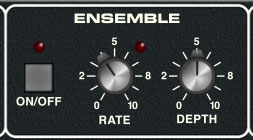
Memorymode includes four super-rad, studio quality effects.
Phaser

Memorymode's phaser is a fat and warbly recreation of the classic phaser stomp boxes of the 70s. Unlike most vintage phasers, it's stereo, that is, its modulation cycles are 180° out of phase for a rich, wide image.
On/Off- Enables and disables the Phaser effect.
Rate- Sets the phaser's internal LFO speed from 0.01 to 7.5 Hz.
Depth- Sets the overall amount of effect.
Ensemble

On/Off- Enables and disables the Ensemble effect.
Rate- Sets the Ensemble's internal LFO speed from 0.01 to 8 Hz.
Depth- Sets the effect depth, i.e. the amount of LFO delay time mod.
Echo

On/Off- Enables and disables the Echo effect.
Time- Sets the delay time from 1-2000 ms.
Sync- Engaging the Sync button locks the delays time to master tempo. When engaged, the Time slider snaps to note values ranging from 1/64th note triplet to 8 beats. Sync mode locks to the tempo in the top toolbar when using the standalone version of Memorymode, or the current project tempo when the plug-in version is used in a DAW.
Feedback- Routes the output to the input for additional repeats. Be careful at high settings as this can result in runaway feedback madness. (Map this knob to a hardware MIDI knob or slider for semi-controller runaway feedback madness.)
Damp- Attenuates high frequencies as the amount is increased. Not only does this create more natural sounding decays, it also reduces the "stacking" effect that occurs with high feedback levels.
Spread- This subtracts delay time from the left channel and adds time to the right channel, creating a wide stereo effect, as well as preventing echoes from "piling up" in the center of the image. Note that the subtracted and added delay effectively offsets the overall delay time setting with each repeat, so long delays combined with high feedback settings can become noticeably off time (like your drummer as the beer cans pile up, am I right people?!?). This can be circumvented by reducing the Spread control (won't help with that drummer situation though).
Mix- Balances the level of dry and wet signal.
Reverb

On/Off- Enables and disables the reverb effect.
Type - Allows selection of room, plate, hall algorithms.
Decay- Sets the overall length of reverb; actual times vary dependent on the reverb type.
Damp- Attenuates high frequencies for more natural sounding reverb.
Mix- Balances the level of dry and wet signal.